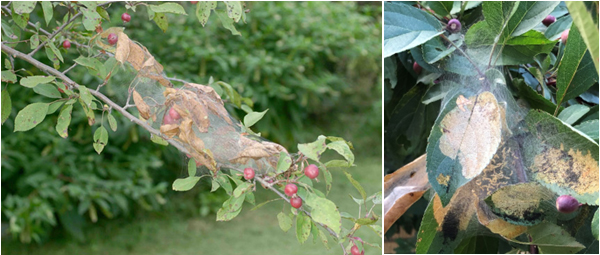Issue 6, August 15, 2023
Fall Webworm
Fall webworms (Hyphantria cunea) are communal caterpillars that spin silk into a tent-like structure at the tip of branches. These webs are often built around the leaves they feed on. Fall webworms feeds on a wide range of deciduous trees and shrubs including, crabapple, redbud, sweet gum, maple and oak. As the caterpillars consume the leaves within the web, they will expand the web every week or so to include more leaves. The web of mature caterpillars can be 2 to 3 feet long.

Left, Fall webworm tent-like webs on crabapple Phil Nixon, University of Illinois at Urbana-Champaign Right, visible larvae, Travis Cleveland, University of Illinois.
There are two races of fall webworm. The northern race caterpillars have yellow-gray bodies with red heads and all white moths. The southern race caterpillars have yellow-green bodies with black heads and adults are white with small black spots on the wings. Their distributions overlap, so they are both found throughout the species range but one is more frequently encountered in the northern and the other more frequently encountered in the southern portions of their range.

Southern fall webworm mature larva, Phil Nixon, University of Illinois.
Adults emerge from late spring to midsummer and begin to deposit hairy egg masses on the underside of leaves. A few days later, the larvae hatch and begin to build silken webs over the ends of branches. You may begin to see their tent-like webs when PeeGee Hydrangea (Hydrangea paniculata Grandiflora) is blooming. Fall webworms usually build webs in the understory of the trees, fence-row shrubs and ornamental shrubs. Young larvae feed on the upper surfaces of leaves and larger larvae feed on whole leaves, leaving the large veins or midribs behind. While fall webworms are capable of causing significant aesthetic damage, the defoliation usually does not threaten overall plant health. This is, in part, because their populations can be well controlled by natural enemies.
Since fall webworms are unlikely to cause enough damage to harm the plant, some aesthetic damage may be tolerated and treatment may not be required. When aesthetic damage cannot be tolerated, there are a number of options for fall webworm control.
Pruning back branches to remove the web is a mechanical control method that can be implemented at any time and can be effective in reducing caterpillar populations quickly.
Chemical and Bt (Bacillus thuringiensis) treatments can be applied as a spray application when webs appear on trees. The webs are water resistance, so a gentle spray will not penetrate the surface. The spray pressure must be great enough to damage the web so the insecticide can coat the leaves inside the web, where caterpillars are feeding. A stick or other tool can also be used to tear open the web before application. Bacillus thuringiensis kurstaki treatments (Dipel, Thuricide, etc.) target caterpillars. They are more effective on caterpillars and have no impact on adult moths. Effective chemical insecticides include carbaryl (Sevin), pyrethroids and other products that are labeled to treat fall webworm.
Author:
Sarah Hughson